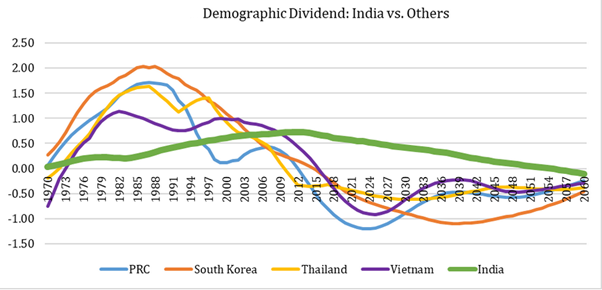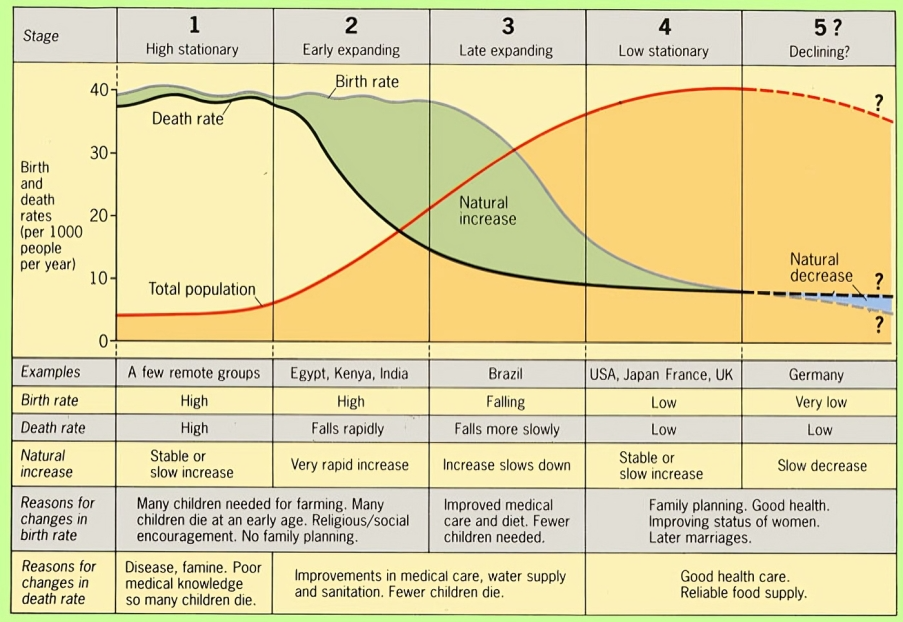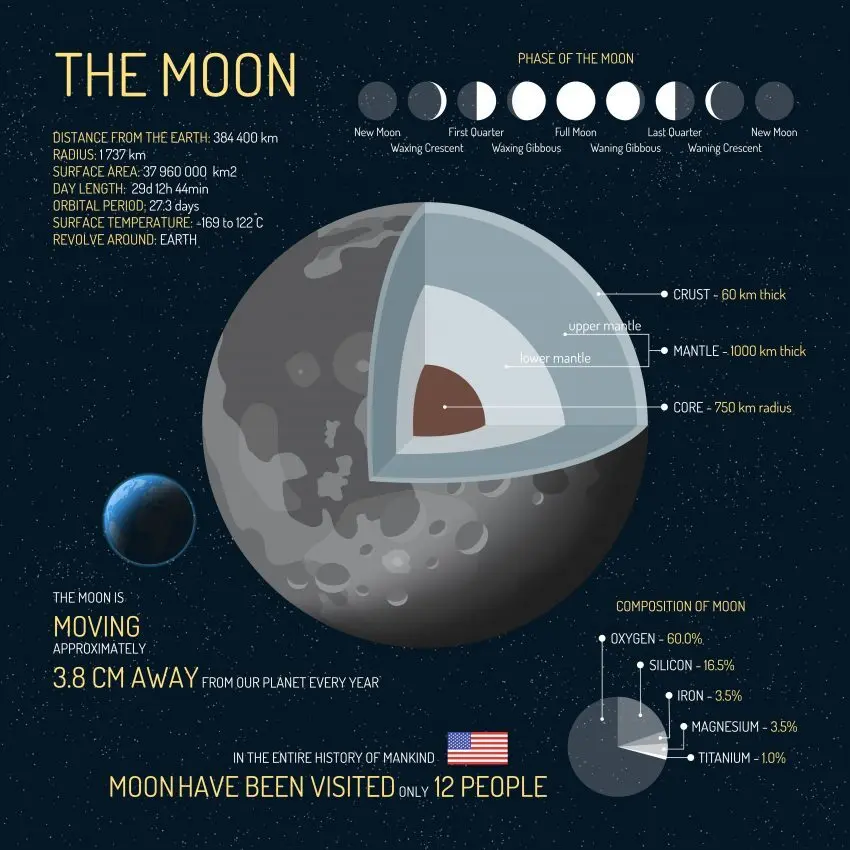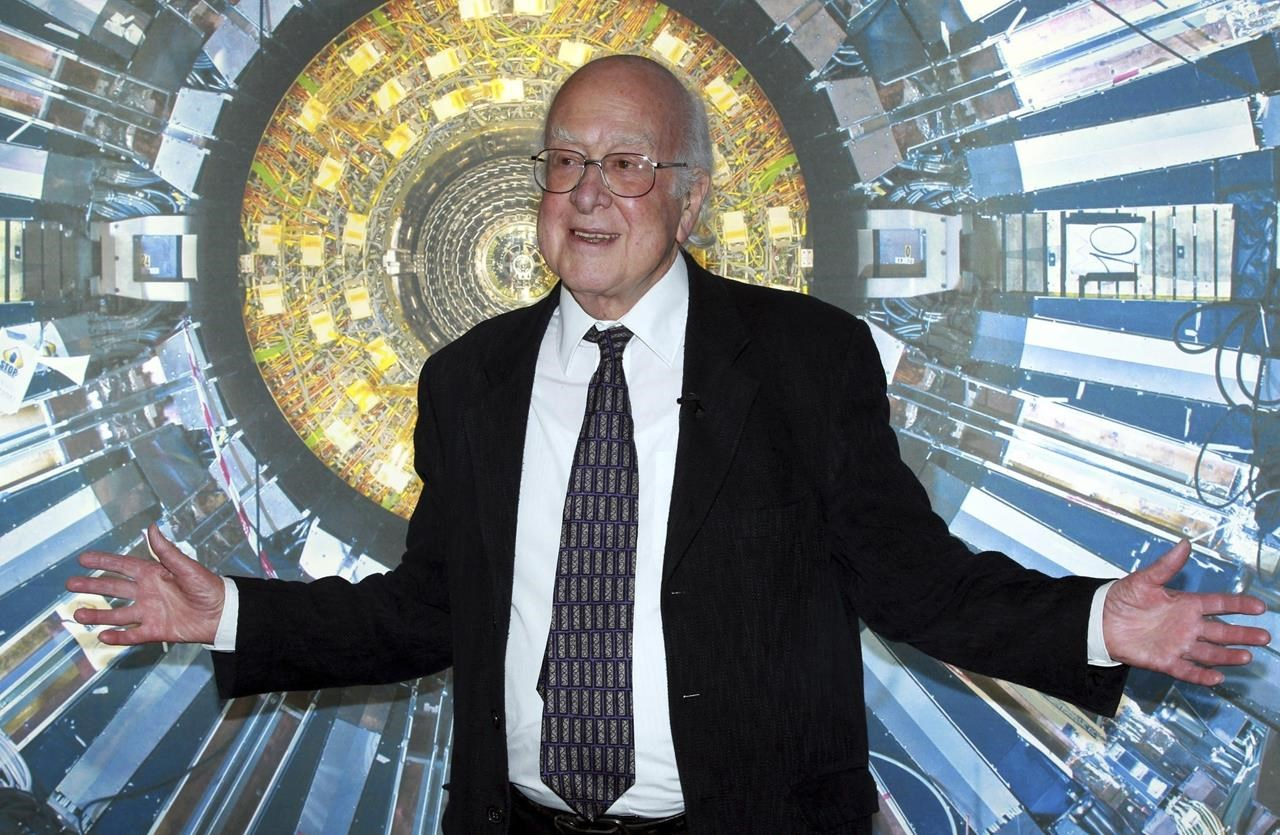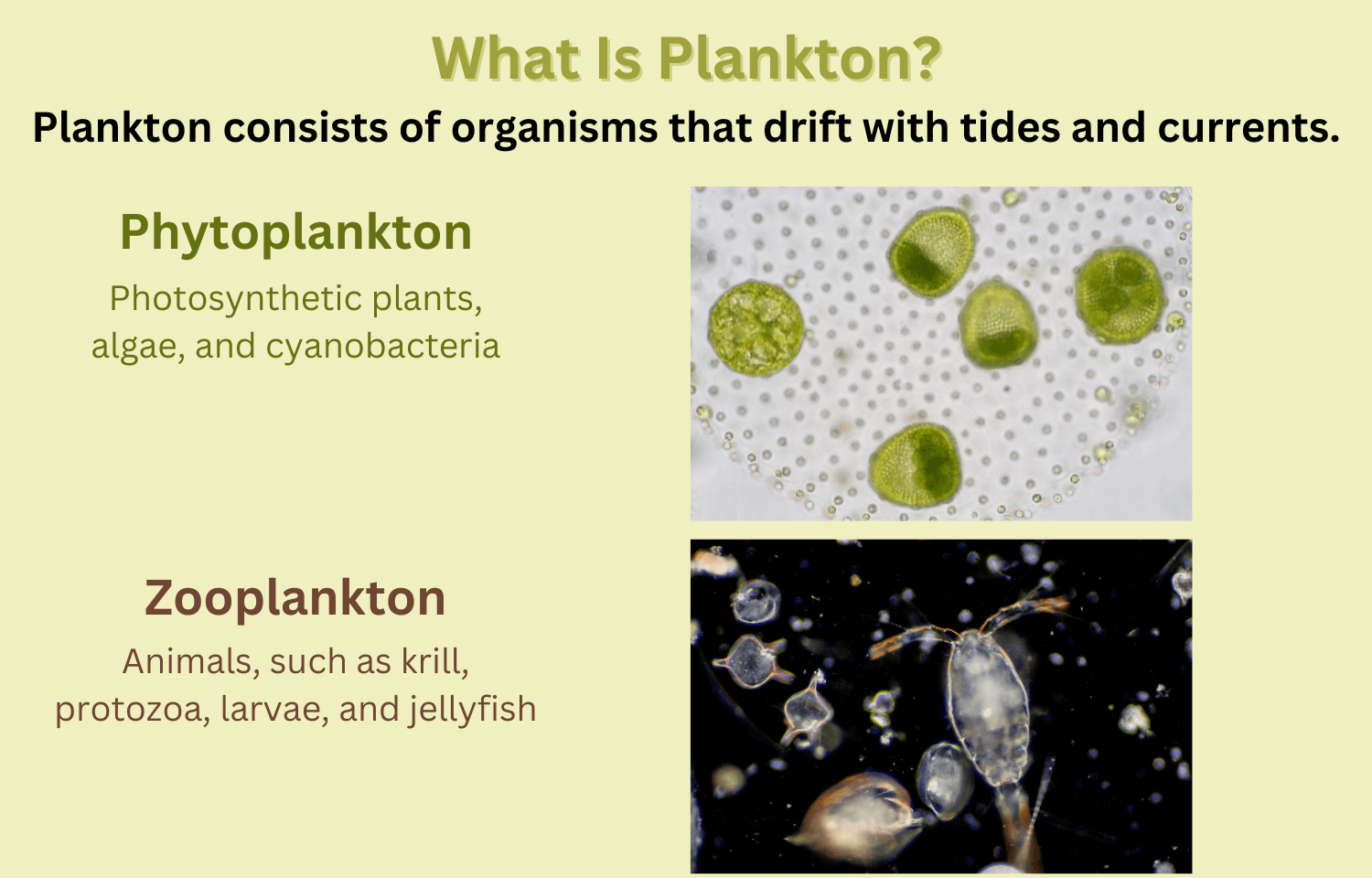Indian Society
Demographic Transition of India
For Prelims: Demographic Dividend, Total Fertility Rate (TFR), Mahatma Gandhi National Rural Employment Guarantee (MGNREGA), Asia 2050 report.
For Mains: Demographic Transition In India, Significance of India’s Demographic Dividend, Challenges Associated with India’s Demographic Dividend.
Why in News?
India's population growth has been a major focus, with projections of reaching 1.7 billion by 2065, according to the UN Population Division, underscoring the ongoing Transition of Demographic Dividend in India.
- It shifts the focus to a crucial but lesser-discussed aspect, declining fertility rates, which according to the Lancet Report is projected to go down to 1.29 by 2051.
- The government's projected Total Fertility Rate (TFR) for the period 2021-2025 (1.94) and 2031-2035 (1.73) is higher than estimates from The Lancet study and NFHS 5 data.
- This suggests that India's population may stabilise below 1.7 billion earlier than 2065.
What is the Demographic Transition and Demographic Dividend?
- A demographic shift refers to a change in the composition of a population over time.
- This change can occur due to various factors such as changes in birth and death rates, migration patterns, and changes in social and economic conditions.
- A demographic dividend is a phenomenon that occurs when a country's population structure shifts from having a high proportion of dependents (children and elderly) to having a higher proportion of working-age adults.
- This change in population structure can result in economic growth and development if the country invests in its human capital and creates conditions for productive employment.
What Factors Triggered Demographic Transition in India?
- Rapid Economic Development:
- The pace of economic development, particularly since the early years of the 21st century, has been a significant driver of demographic transition.
- Economic growth leads to improved living standards, better healthcare facilities, and increased access to education, which collectively contribute to lower fertility rates.
- Reduction in Infant and Child Mortality Rates:
- Lower mortality rates among infants and children have reduced the need for families to have a large number of children for old-age support.
- As healthcare facilities improve and child mortality decreases, families feel more confident in having fewer children.
- Rise in Women's Education and Work Participation Rates:
- Increased education and participation of women in the workforce have also played a crucial role.
- As women become more educated and financially independent, they tend to have fewer children and delay childbirth, leading to a decline in total fertility rates.
- Improvement in Housing Conditions:
- Better housing conditions and access to basic amenities contribute to improved quality of life, which, in turn, affects family planning decisions.
- Families may opt for smaller family sizes when they have better living conditions.
What are the Challenges of Demographic Transition in India?
- Dependency Ratio Shift:
- While initially, the decline in TFR leads to a fall in the dependency ratio and a larger working-age population, it eventually results in a larger share of elderly dependents.
- This places a strain on resources for healthcare and social welfare, similar to the situations observed in China, Japan, and European countries.
- Uneven Transition Across States:
- The decline in fertility rates is not uniform across all states in India. Some states, particularly larger ones like Uttar Pradesh, Bihar, and Jharkhand, may take longer to achieve replacement level fertility.
- This can exacerbate regional disparities in economic development and healthcare access.
- Labour Productivity and Economic Growth:
- While the demographic transition can potentially increase labour productivity and spur economic growth, it also poses challenges in terms of managing the aging workforce and ensuring adequate skills development for the younger population.
What are the Opportunities of Demographic Transition in India?
- Enhanced labour Productivity:
- The demographic transition can lead to a deceleration in population growth.
- This can result in a higher availability of capital resources and infrastructure on a per capita basis, ultimately boosting labour productivity.
- Reallocation of Resources:
- Decreasing fertility rates enable the reallocation of resources towards education and skill development, which can lead to improved human capital and workforce productivity.
- A declining TFR will lead to a situation where the number of children enrolling in schools is lower, as is already happening in states like Kerala.
- This could improve educational outcomes without additional resources being spent by the state.
- Decreasing fertility rates enable the reallocation of resources towards education and skill development, which can lead to improved human capital and workforce productivity.
- Increased Women Participation in Workforce:
- A major factor responsible for the low participation of women in the workforce is their engagement in childcare at an age when they should be in the labour force.
- With less time needed for childcare, one would expect more women to join the labour force in the coming decades.
- The larger share of women in employment schemes like Mahatma Gandhi National Rural Employment Guarantee (MGNREGA) indicates a trend towards greater female labour force participation.
- Spatial Redistribution of labour:
- Movement of labour from regions with surplus labour to regions with growing industries can create spatial balance in the labour market.
- This would get an impetus with the modern sectors in the southern states, and Gujarat and Maharashtra, soliciting cheaper labour from the northern states.
- This, over the years, must result in improved working conditions, elimination of wage discrimination for migrant workers and the mitigation of security concerns in the receiving states through institutional safeguards.
Way Forward
- As mentioned in the Asia 2050 report, if India capitalises on these opportunities by focusing on sectoral and spatial redistribution of the workforce, skill development, and increasing women's participation in the workforce, it can emerge as a major economic player in the 21st century.
- India's demographic dividend, if harnessed effectively, can contribute significantly to global economic competitiveness.
- The evolving population dynamics have serious implications for policy formulation, particularly regarding healthcare, education, and skill development.
- There is a need for policies that address the specific needs of women and other marginalised groups, ensuring inclusive growth and development.
|
Drishti Mains Question: Q. Discuss the significance of India's demographic transition in the context of its potential economic growth and global competitiveness. Highlight the opportunities presented by declining fertility rates, increased women's participation in the workforce, and spatial redistribution of labour. |
UPSC Civil Services Examination, Previous Year Questions (PYQs)
Prelims:
Q1. In the context of any country, which one of the following would be considered as part of its social capital? (2019)
(a) The proportion of literates in the population
(b) The stock of its buildings, other infrastructure and machines
(c) The size of population in the working age group
(d) The level of mutual trust and harmony in the society
Ans: (d)
Q2. India is regarded as a country with “Demographic Dividend”. This is due to (2011)
(a) Its high population in the age group below 15 years
(b) Its high population in the age group of 15-64 year
(c) Its high population in the age group above 65 years
(d) Its high total population
Ans: (b)
Mains:
Q1. Discuss the main objectives of Population Education and point out the measures to achieve them in India in detail. (2021)
Q2. ‘’Empowering women is the key to control the population growth.’’ Discuss. (2019)
Q3. Critically examine whether growing population is the cause of poverty or poverty is the main cause of population increase in India. (2015)
Governance
SC Concerned by Growing States' Appeals Against Centre
For Prelims: Supreme Court, National Disaster Response Fund (NDRF), Disaster Management Act, 2005, State Disaster Response Fund
For Mains: Disaster Management, Government Policies & Interventions, States Borrowing Power, Centre-State Relations
Why in News?
The Supreme Court of India has expressed concern over a growing trend of States being compelled to approach it against the Centre.
What Instances Prompted the SC's Caution?
- Tamil Nadu:
- Tamil Nadu accused the Centre of neglecting the State's needs by delaying disaster relief funds worth nearly Rs. 38,000 crore.
- Kerala:
- Kerala filed a suit directly in the Supreme Court, blaming the Centre for interfering in its 'Net Borrowing Ceiling' (quantified as 3% of its projected Gross State Domestic Product for 2023-24, pushing the State to a financial emergency.
- Karnataka:
- Karnataka's request for ₹18,171.44 crore under the National Disaster Response Fund (NDRF) to address a humanitarian crisis has been unanswered for six months.
- The state argues that the Centre's inaction violates not only the statutory provisions of the Disaster Management Act, 2005 but also fundamental rights of the people of the state, guaranteed under the Constitution of India, including the right to equality and the right to life.
- The State faces severe drought conditions, with a significant deficit in rainfall, affecting the lives of its people.
What are the Constitutional Provisions for States’s Borrowing Power and Dispute Settlement with the Centre?
- Article 293:
- The executive power of a State extends to borrowing within India's territory, secured by the Consolidated Fund of the State.
- The Government of India may make loans to States or provide guarantees, subject to conditions set by Parliament.
- States cannot raise loans without the consent of the Government of India if any part of a previous loan from the Government of India remains outstanding.
- Consent for borrowing may be granted by the Government of India with imposed conditions if necessary.
- Article 131:
- It deals with the original jurisdiction of the Supreme Court. This means it empowers the Supreme Court to directly hear and decide disputes between:
- The Central Government and one or more State Governments
- Two or more State Governments
- Essentially, it acts as a referee in disagreements between the central government and state governments, or between different state governments themselves.
- It deals with the original jurisdiction of the Supreme Court. This means it empowers the Supreme Court to directly hear and decide disputes between:
Centre-State Relations in India's Governance |
||
| Aspect | Constitutional Provisions | Key Features |
| Legislative Relations | Articles 245 to 255 |
|
| Administrative Relations | Articles 256 to 263 |
|
| Financial Relations | Articles 264 to 293 |
|
What is the Central Government's Role in Disaster Recovery Plans for States?
- Disaster Management Act, 2005:
- The Disaster Management Act, 2005 lays down the institutional, legal, financial, and coordination mechanisms at the national, state, district, and local levels for disaster management.
- The act mandates the establishment of various authorities and committees, such as the National Disaster Management Authority (NDMA) and State and District Disaster Management Authorities to oversee and implement disaster management efforts.
- The act empowers the central government to issue directions to the NDMA, state governments/SDMAs, or any of their officers/employees to facilitate or assist in disaster management.
- The Finance Commission recommends the creation of funds for disaster mitigation along with disaster response, which will now together be called National Disaster Risk Management Fund (NDRMF) and State Disaster Risk Management Funds (SDRMF).
- The 15th Finance Commission recommended the National Disaster Mitigation Fund (NDMF) for the period 2021-26, alongside the NDMF, the State DMFs have been set up.
- The SDMFs are contributed by both the Central Government and the State Governments, with a 75:25 ratio for general states and a 90:10 ratio for northeastern and Himalayan states.
- The Disaster Management Act, 2005 lays down the institutional, legal, financial, and coordination mechanisms at the national, state, district, and local levels for disaster management.
- State Disaster Response Fund (SDRF):
- The SDRF, constituted under the Disaster Management Act, 2005, is the primary fund available with State Governments for responses to notified disasters.
- The Central Government contributes 75% of SDRF allocation for general category States/UTs and 90% for special category States/UTs (NE States, Sikkim, Uttarakhand, Himachal Pradesh, Jammu and Kashmir).
- The annual central contribution is released in two equal instalments as per the recommendation of the Finance Commission.
- SDRF shall be used only for meeting the expenditure for providing immediate relief to the victims.
- Disasters covered under SDRF: Cyclone, drought, earthquake, fire, flood, tsunami, hailstorm, landslide, avalanche, cloudburst, pest attack, frost and cold waves.
- The SDRF, constituted under the Disaster Management Act, 2005, is the primary fund available with State Governments for responses to notified disasters.
- National Disaster Response Fund (NDRF):
- The NDRF, established under Section 46 of the Disaster Management Act, 2005, is a fund managed by the Central Government to address emergency response, relief, and rehabilitation during threatening disaster situations or disasters.
- It supplements the SDRF of a State, in case of a disaster of a severe nature, provided adequate funds are not available in the SDRF.
- The fund is placed in the "Public Account" of the Government of India under "reserve funds not bearing interest," enabling the government to utilise it without parliamentary approval.
- NDRF is financed through a cess levied on specific items subject to excise and customs duty, approved annually through the Finance Bill.
- Additional funding requirements beyond NDRF allocations are met through general budgetary resources, ensuring continuous support for disaster relief efforts.
- The fund's utilisation is overseen by the National Executive Committee (NEC) of the NDMA, with annual audits conducted by the Comptroller and Auditor General (CAG) to ensure transparency and accountability.
- The NDRF, established under Section 46 of the Disaster Management Act, 2005, is a fund managed by the Central Government to address emergency response, relief, and rehabilitation during threatening disaster situations or disasters.
What are the Challenges faced by States Regarding Disbursement of Financial Aids?
- Delayed and Insufficient Disaster Relief:
- Lack of coordination between the Centre and states in the disbursement of disaster management funds (NDRF and SDRF).
- Concerns over the Centre's unilateral decision-making in determining the quantum of disaster assistance.
- Lack of clear, transparent, and objective criteria for the Centre to determine the quantum of disaster relief and rehabilitation assistance to states.
- Absence of enough institutionalised mechanisms for states to challenge the Centre's decisions on disaster aid.
- Lack of coordination between the Centre and states in the disbursement of disaster management funds (NDRF and SDRF).
- Imbalance in the Centre-State Disaster Management Framework:
- Perceived over-centralisation of disaster management powers and decision-making authority with the Centre.
- Concerns over the NDMA being overly dependent on the Centre and lacking effective representation of states.
- Lack of flexibility for states to customise disaster response and mitigation measures as per their local contexts and priorities.
- Centralised Planning:
- Centralised planning may not always take into account the unique needs and circumstances of each state, leading to inefficiencies in the response to disasters or other situations requiring aid.
- Political Dynamics:
- Political dynamics and relationships between the central government and the states can influence aid distribution, sometimes leading to allegations of bias or favouritism.
- Lack of Consultation:
- The Centre is often accused of not adequately consulting the states while formulating policies and schemes, leading to implementation challenges.
- Instances of the Centre unilaterally imposing decisions on the states without their consent have been a source of friction.
- Lack of effective institutional platforms for regular dialogue and dispute resolution between the Centre and states.
- Weakening of federal spirit and collaborative approach in the face of growing competitive and adversarial politics.
Way Forward
- Enhance fiscal federalism by reviewing taxation powers and revenue sharing, addressing fiscal imbalances.
- Revitalise institutional platforms for regular dialogue and consensus-building between the Centre and states. Promote collaborative policymaking and effective dispute resolution mechanisms to address Centre-state conflicts.
- Improve transparency in decision-making for disaster relief funds and aid utilisation. Enhance audit and oversight to prevent misappropriation and discrimination.
- Promote a political culture that prioritises national interests over partisan agendas and encourages cooperation and mutual respect between the Centre and state levels. Educate citizens about the importance of cooperative federalism for effective governance and equitable growth.
|
Drishti Mains Question: Q. How does political dynamics and insufficient consultation hinder Centre-State cooperation during crises and suggest reforms to foster greater collaborative federalism? |
UPSC Civil Services Examination, Previous Year Questions (PYQs)
Prelims
Q1. Which one of the following is not a feature of Indian federalism? (2017)
(a) There is an independent judiciary in India.
(b) Powers have been clearly divided between the Centre and the States.
(c) The federating units have been given unequal representation in the Rajya Sabha.
(d) It is the result of an agreement among the federating units.
Ans: (d)
Q2. Local self-government can be best explained as an exercise in (2017)
(a) Federalism
(b) Democratic decentralisation
(c) Administrative delegation
(d) Direct democracy
Ans: (b)
Mains
Q. Discuss the recent measures initiated in disaster management by the Government of India departing from the earlier reactive approach. (2020)
Q. With reference to National Disaster Management Authority (NDMA) guidelines, discuss the measures to be adopted to mitigate the impact of the recent incidents of cloudbursts in many places of Uttarakhand. (2016)

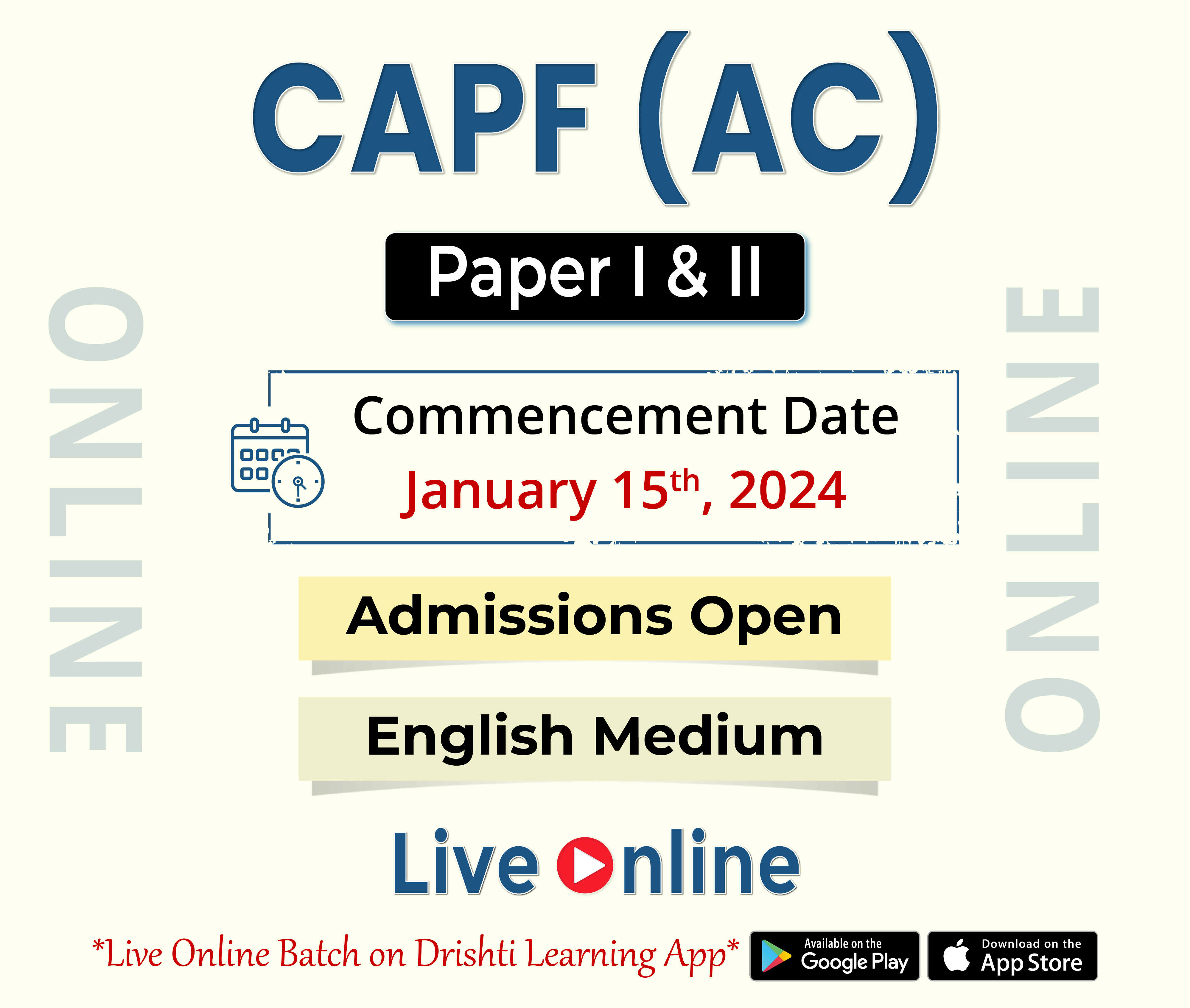
Governance
Right to Privacy for Election Candidate
For Prelims: Supreme Court, Election Commission, Right to Privacy, Representation of People’s Act, 1951.
For Mains: Balance between the Right to Privacy and Transparency in the Electoral Process, Electoral Reforms, Making elections more fair and transparent.
Why in News?
Recently, the Supreme Court of India in its recent judgement has ruled that every candidate contesting in the elections need not declare each and every movable asset it possesses.
- The Court ruled that Candidates too have a Right to Privacy from the voters and they cannot lay their life out thread-bare for examination.
What are the Key Facts About the Case?
- The SC was hearing a petition filed by an MLA from Arunachal Pradesh challenging a 2023 Guwahati High Court judgement that declared his election null and void for not declaring three vehicles as his assets in his affidavit filed in the form appended to the Conduct of Election Rules, 1961.
- The petition said that the electoral candidate committed a “corrupt practice" under Section 123 of the Representation of People Act (RPA), 1951 by not declaring the ownership of said vehicles.
- Supreme Court said that a candidate’s choice to retain his privacy on matters that were of no concern to the voters or were irrelevant to his candidature for public office did not amount to a “corrupt practice” under Section 123 of the RRA, 1951.
- Also, such non-disclosure would not amount to a “defect of a substantial nature” under Section 36(4) of the 1951 Act.
- The court said that voters have a right to the disclosure of information which was essential for choosing the candidate for whom a vote should be cast.
What is the Right to Privacy?
- The right to privacy is a fundamental right, which protects the inner sphere of the individual from interference from both State and non-state actors and allows the individuals to make autonomous life choices.
- The Supreme Court described privacy and its importance in the landmark decision of K.S. Puttaswamy vs Union of India in 2017 that the right to Privacy is a fundamental and inalienable right and attaches to the person covering all information about that person and the choices that he/she makes.
- The right to privacy is protected as an intrinsic part of the right to life and personal liberty under Article 21.
What is RPA 1951 and the Corrupt Practices under the Act?
- About:
- The RPA of 1951 governs the conduct of elections and the qualifications and disqualifications of elected representatives.
- Provisions:
- It regulates the conduct of elections.
- It specifies the qualifications and disqualifications for membership in the parliament of legislative houses,
- It provides provisions to curb corrupt practices and other offences.
- It lays down the procedure for settling doubts and disputes arising out of elections.
- Section 36(4) in the Act of 1951 mentions that the returning officer shall not reject any nomination paper on the grounds of any defect that is not of a substantial character.
- Corrupt Practices under RPA, 1951:
- Corrupt Practices: Section 123 of the Act defines ‘corrupt practices’ to include bribery, undue influence, false information, and promotion of “feelings of enmity or hatred between different classes of the citizens of India on grounds of religion, race, caste, community, or language” by a candidate for the furtherance of his prospects in the election.
- In Abhiram Singh versus C. D. Commachen Case (2017) SC ruled that candidates are prohibited from appealing for votes not only based on their own religion but also on that of the voters.
- Undue Influence: The section defines undue influence as any direct or indirect interference, including threats, that hinders the free exercise of electoral rights.
- Disqualification: Section 123(4) allows disqualification of an elected representative for certain offences, corrupt practices, failure to declare election expenses, or having interests in government contracts or works.
- Corrupt Practices: Section 123 of the Act defines ‘corrupt practices’ to include bribery, undue influence, false information, and promotion of “feelings of enmity or hatred between different classes of the citizens of India on grounds of religion, race, caste, community, or language” by a candidate for the furtherance of his prospects in the election.
- Significance:
- The act is significant for the smooth functioning of Indian democracy as it bars the entry of persons with criminal backgrounds into representative bodies, thus decriminalising Indian politics.
- The act requires every candidate to declare his assets and liabilities and maintain an account of election expenses.
- This provision ensures the accountability and transparency of the candidate in the use of public funds.
- It prohibits corrupt practices like booth capturing, bribery or promoting enmity etc., which ensures the legitimacy and free & fair conduct of elections.
- The act provides that only those political parties that are registered under section 29A of the RPA Act,1951 are eligible to receive electoral bonds, and ensuring transparency in electoral funding.
|
Driahti Mains Question: Q. Discuss the implications of the recent Supreme Court judgment on the right to privacy of election candidates regarding the disclosure of assets. |
UPSC Civil Services Examination Previous Year Question (PYQ)
Prelims:
Q. ‘Right to Privacy’ is protected under which Article of the Constitution of India?
(a) Article 19
(b) Article 20
(c) Article 21
(d) Article 29
Ans: c
Q2. Right to Privacy is protected as an intrinsic part of Right to Life and Personal Liberty. Which of the following in the Constitution of India correctly and appropriately imply the above statement? (2018)
(a) Article 14 and the provisions under the 42nd Amendment to the Constitution.
(b) Article 17 and the Directive Principles of State Policy in Part IV.
(c) Article 21 and the freedoms guaranteed in Part III.
(d) Article 24 and the provisions under the 44th Amendment to the Constitution.
Ans: (c)
Mains:
Q. Examine the scope of Fundamental Rights in the light of the latest judgement of the Supreme Court on the Right to Privacy. (2017)
Q. “There is a need for simplification of procedure for disqualification of persons found guilty of corrupt practices under the Representation of Peoples Act”. Comment. (2020)

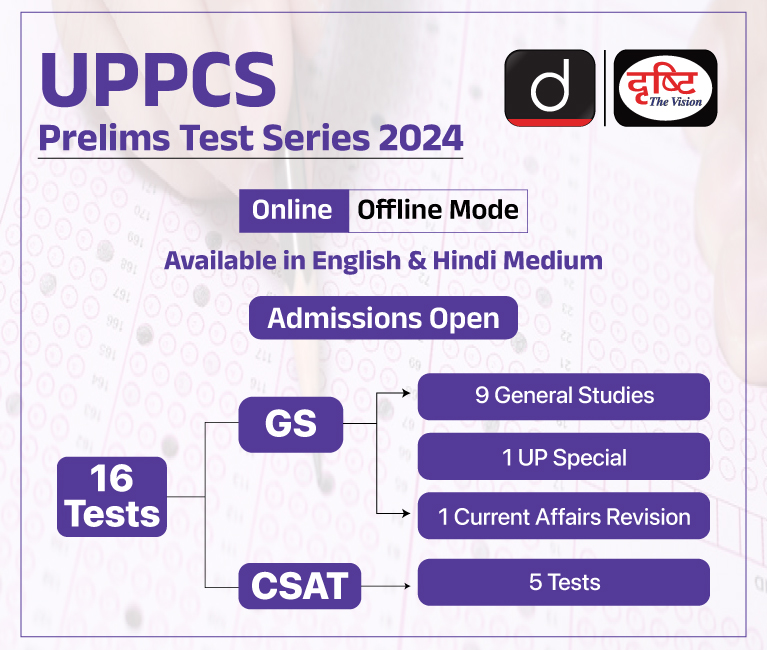
Important Facts For Prelims
Time Zone for Moon
Why in the News?
Recently, the European Space Agency is planning a universal timekeeping system for the moon.
What is Timekeeping on the Moon?
- About:
- The Moon (the only natural Satellite of earth) has its own day and night cycle, which lasts about 29.5 Earth days.
- Currently, the time on the Moon is measured using Universal Time Coordination (UTC), which is the same timekeeping system used on the Earth.
- 'Coordinated Lunar Time' (LTC) will be the unified time standard for the Moon.
- To decide LTC, there will be a need to place at least three atomic clocks on the lunar surface that will tick at the Moon’s natural pace, and whose output will be combined by an algorithm to generate a more accurate virtual timepiece.
- Need of LTC:
- LTC will provide a time-keeping benchmark for lunar spacecraft and satellites that require extreme precision for their missions.
- It will also synchronise the communication between satellites, astronauts, bases and the Earth.
- Because the Moon’s day is much longer than Earth’s day, it would be difficult to use UTC for day-to-day activities on the Moon.
- The International Space Station, being in low Earth orbit, will continue to use coordinated universal time (UTC).
- Moon has a lesser gravitational force than Earth. Compared to Earth, time on the Moon moves 58.7 microseconds quicker every day.
- An atomic clock on the moon will tick at a different rate than a clock on Earth.
- To address this issue, researchers have proposed creating a lunar time zone that would be based on the Moon’s day and night cycle.
- This would make it easier for lunar settlers to keep track of time and coordinate activities.
- Having a lunar time zone would also make it easier for researchers to conduct experiments and collect data on the Moon.
- It would also help to prevent confusion and errors that could arise from using different timekeeping systems on Earth and the Moon.
- Challenges:
- Implementing a unified time standard for the Moon requires extensive global cooperation and consensus on the scientific intricacies of timekeeping.
What is Universal Time Coordinated (UTC)?
- Universal Time Coordinated (UTC) is a time standard used to keep time consistent around the world.
- UTC is based on International Atomic Time (TAI), which is maintained by atomic clocks around the world.
- It is the primary time standard used by many countries, international organisations, and scientific research institutions.
- UTC is expressed as a 24-hour clock and is used to indicate the time offset from Coordinated Universal Time (UTC+0).
- Time zones are defined as an offset from UTC, with some time zones being ahead of UTC (UTC+1, UTC+2, etc.) and others being behind UTC (UTC-1, UTC-2, etc.).
- UTC is adjusted periodically to account for changes in the Earth’s rotation, which can cause variations in the length of a day.
- These adjustments are made by adding leap seconds to UTC, which helps keep the time standard synchronised with the Earth’s rotation.
What are Atomic Clocks?
- An atomic clock, is a clock, known for its exceptional accuracy, and functions by utilising specific resonance frequencies of atoms, typically cesium or rubidium.
- In atomic time, a second is defined as the period in which a caesium atom vibrates 9,192,631,770 times.
- It was invented in 1955 by Louise Essen.
- The extreme precision levels of the atomic clocks can be interpreted by the fact that they will lose one second approximately every 100 million years.
- Currently, atomic clocks in India are operational in Ahmedabad and Faridabad.
Read more: 2 Time Zones in India
UPSC Civil Service Examination, Previous Year Questions(PYQs)
Q.1 Selene-1, the lunar orbiter mission belongs to which one of the following? (2008)
(a) China
(b) European Union
(c) Japan
(d) USA
Ans: (c)
Q.2 What is the purpose of the US Space Agency’s Themis Mission, which was recently in the news? (2008)
(a) To study the possibility of life on Mars
(b) To study the satellites of Saturn
(c) To study the colourful display of high latitude skies
(d) To build a space laboratory to study the stellar explosions
Ans: (c)
Q. Which one of the following planets has largest number of natural satellites or moons? (2009)
(a) Jupiter
(b) Mars
(c) Saturn
(d) Venus
Ans: (a)
Q. Tides occur in the oceans and seas due to which among the following? (2015)
- Gravitational force of the Sun
- Gravitational force of the Moon
- Centrifugal force of the Earth
Select the correct answer using the code given below:
(a) 1 only
(b) 2 and 3 only
(c) 1 and 3 only
(d) 1, 2 and 3
Ans: (d)


Important Facts For Prelims
New Year Festivals Across India
Why in News?
Recently, traditional Hindu New Year festivals like Chaitra Sukladi, Ugadi, Gudi Padwa, Cheti Chand, Navreh, and Sajibu Cheiraoba were celebrated across India, fostering cultural unity and appreciation.
What are the Major Traditional Indian New Year Festivals?
- Chaitra Sukladi:
- Celebrated in North India, marks the beginning of the Hindu New Year.
- The Hindu New Year Vikram Samvat begins with the new moon of the month of Chaitra.
- According to popular tradition, King Vikramaditya of Ujjain established the Vikrama Samvat era after defeating the Sakas.
- The earliest known inscription which calls the era "Vikrama" is from 842 CE.
- Celebrated in North India, marks the beginning of the Hindu New Year.
- Ugadi:
- Ugadi marks the commencement of the Hindu New Year and is observed in Andhra Pradesh, Telangana and Karnataka.
- The terms Yugadi or Ugadi stem from the Sanskrit words yuga (age) and adi (beginning), denoting the start of a new age.
- Panchanga Sravanam, the reading of the almanac for the new year, is an important ritual.
- Ugadi marks the commencement of the Hindu New Year and is observed in Andhra Pradesh, Telangana and Karnataka.
- Gudi Padwa:
- Gudi Padwa, also known as Samvatsar Padvo, is observed in Maharashtra and Goa.
- It marks the beginning of Marathi New Year and is also observed as the first day of Chaitra Month.
- Marks the beginning of the Hindu New Year and the Marathi New Year.
- Cheti Chand:
- Celebrated by the Sindhi community.
- Marks the beginning of the Sindhi New Year.
- The festival of Cheti Chand is observed by Sindhis to commemorate the birth of Jhulelal, also called Uderolal, who is considered their patron saint.
- Navreh:
- Celebrated by the Kashmiri Pandit community.
- Navreh is derived from Sanskrit Nava Varsha, meaning the new year.
- Kashmiri Pandits dedicate the Navreh festival to their Goddess Sharika and pay homage to her during the festival.
- Sajibu Cheiraoba:
- Sajibu Cheiraoba, also known as Meitei Cheiraoba, is a traditional festival celebrated in the northeastern Indian state of Manipur.
- It marks the beginning of the Manipuri lunar calendar year and is observed by the Meitei community, who are the majority ethnic group in Manipur.


Important Facts For Prelims
First General Election 1951-52
Why in News?
As India gears up for the 2024 general election, the historic importance of the country's first Lok Sabha election in 1951-52 is gaining attention. This inaugural election was a pivotal moment in India's democratic evolution.
What are the Key Facts About India's First General Elections?
- Historic Vote:
- Independent India’s first general elections were held between 25th October 1951 and 21st February 1952. It was a humongous exercise in which a sixth of the world’s population was going to vote, making it the largest election conducted in the world at the time.
- Ultimately, 17.32 crore voters from across the country (excluding Jammu and Kashmir) were enrolled, and 45% were women.
- This was the first time such a massive exercise of universal adult franchise was undertaken, with 176 million electors above the age of 21(the voting age was brought to 18 only in 1989, the Constitution (Sixty-first Amendment) Act, 1989), of whom 82% were unlettered.
- Independent India’s first general elections were held between 25th October 1951 and 21st February 1952. It was a humongous exercise in which a sixth of the world’s population was going to vote, making it the largest election conducted in the world at the time.
- Legal Framework:
- The Parliament enacted the Representation of the People Acts of 1950 and 1951 laying down the groundwork for voter qualifications, election machinery, and other electoral processes.
- The Election Commission of India (ECI) was set up in January, 1950, with Sukumar Sen as the Chief Election Commissioner.
- Election Machinery:
- Coloured ballot boxes and ballot papers the size of a Re 1 currency note were used to aid the largely illiterate electorate.
- In 1951, India's low literacy rate of 18.33% led to the idea of using different coloured ballot boxes for each candidate, but this was deemed impractical. Instead, it was decided to use separate ballot boxes for each candidate at all booths, with the candidate's election symbol on it.
- The ballot papers pink in color, with "Election Commission India" and a serial number with two letters denoting the state - HY for Hyderabad State, BR for Bihar, AS for Assam, etc.
- Coloured ballot boxes and ballot papers the size of a Re 1 currency note were used to aid the largely illiterate electorate.
- Political Landscape and Party Participation:
- There were 53 political parties, of which 14 were national. These included the Indian National Congress, the Communist Party of India, the Socialist Party, the Kisan Mazdoor Praja Party, and Akhil Bharatiya Hindu Mahasabha, among others.
- Election Outcome:
- The Indian National Congress, led by Jawaharlal Nehru, emerged as the dominant political force, securing 318 out of 489 Lok Sabha seats, consolidating its position as the ruling party.
- The Communist Party of India (CPI) emerged as the runner-up in the first Lok Sabha election, followed by the Socialist Party and other political parties.
- The Indian National Congress, led by Jawaharlal Nehru, emerged as the dominant political force, securing 318 out of 489 Lok Sabha seats, consolidating its position as the ruling party.
UPSC Civil Services Examination, Previous Year Questions (PYQs)
Prelims:
Q. Consider the following statements: (2018)
- In the first Lok Sabha, the single largest party in the opposition was the Swatantra Party.
- In the Lok Sabha, a “Leader of the Opposition” was recognised for the first time in 1969.
- In the Lok Sabha, if a party does not have a minimum of 75 members, its leader cannot be recognised as the Leader of the Opposition.
Which of the statements given above is/are correct?
(a) 1 and 3 only
(b) 2 only
(c) 2 and 3 only
(d) 1, 2 and 3
Ans: (b)
Q. Consider the following statements: (2017)
- The Election Commission of India is a five-member body.
- The Union Ministry of Home Affairs decides the election schedule for the conduct of both general elections and bye-elections.
- Election Commission resolves the disputes relating to splits/mergers of recognised political parties.
Which of the statements given above is/are correct?
(a) 1 and 2 only
(b) 2 only
(c) 2 and 3 only
(d) 3 only
Ans: (d)


Rapid Fire
India's Achievements in QS World University Rankings
India's higher education and research landscape has shown significant progress in the 2024 QS World University Rankings by subject, reflecting the country's growing presence in the global academic community.
- IIM-Ahmedabad, IIM-Bangalore, and IIM-Calcutta ranked among the top 50 institutions globally for business and management studies.
- Jawaharlal Nehru University achieved the 20th position globally for development studies, making it the highest-ranked university in India.
- The Saveetha Institute of Medical and Technical Sciences in Chennai secured the 24th position globally for dentistry studies.
- India emerged as one of the world's most rapidly expanding research centres, showing a 54% surge in research output from 2017 to 2022.
- India ranks 4th in research volume globally, trailing behind China, the US, and the UK, but ranks 9th for research impact.
- In the broader Asian context, India ranks 2nd for the number of universities featured and holds the 4th position in the total number of ranked entries.
- India faces challenges in securing citations in premier global journals, with only 15% of its research cited in top-tier journals between 2017 and 2021.
Read more: QS World Ranking 2024


Rapid Fire
God Particle or Higgs Boson
The recent passing of Nobel laureate physicist Peter Higgs has brought attention back to the elusive particle he theorised in the 1960s, known as the 'God particle' or Higgs boson.
- The Higgs boson, an elementary particle akin to electrons or quarks, plays a crucial role in imparting mass to other fundamental particles.
- Peter Higgs, first proposed the existence of the Higgs field and the associated Higgs boson in the 1960s.
- The Higgs boson is the quantum excitation of the Higgs field, which is believed to permeate the entire universe and interact with other particles, giving them mass.
- The discovery of the Higgs boson completed what is known as the Standard Model of Particle Physics, which describes all the fundamental particles (electrons and protons, and the forces, like electromagnetism, gravitation or nuclear forces, that build up the material part of the world).
- According to the Standard Model of Particle Physics, particles gain their mass by interacting with the Higgs field, which is present throughout the universe.
- The stronger a particle interacts with the Higgs field, the more it "feels" the field and the more massive it becomes.
- The Higgs boson was experimentally discovered in 2012 at the Large Hadron Collider (LHC) at CERN (Conseil Européen pour la Recherche Nucléaire), the European Organization for Nuclear Research.
Read more: Nobel Prize in Physics 2023

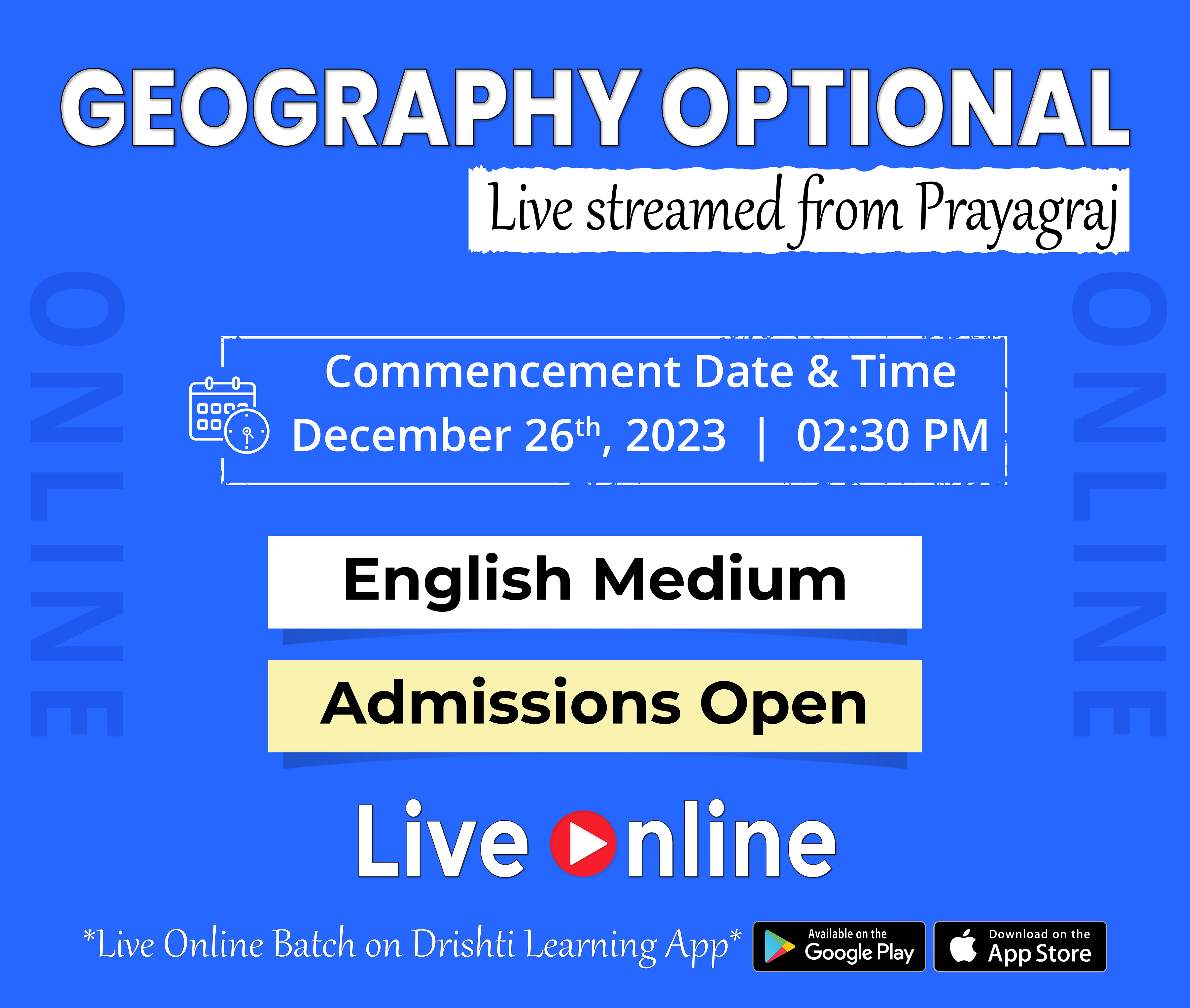
Rapid Fire
Plankton Crash
Recently, the National Green Tribunal (NGT) panel has attributed the cause of the sea turning red in Puducherry to the phenomenon of the plankton crash.
- Ruling out algal bloom and contamination due to effluents, the NGT panel suggested
- that there was a high iron concentration, which favoured plankton bloom.
- A significant portion of a specific unicellular phytoplankton species, Noctiluca scintillans, was responsible for the discharge of red pigment into the water.
- The environmental parameters such as sea surface temperature, water salinity, pH, and dissolved oxygen were conducive to the phytoplankton crash.
Algal Bloom:
- An algal bloom can be defined as a rapid increase in the population of algae in an aquatic ecosystem.
- It is usually recognised by the discolouration on the surface of the water due to the introduction of a nutrient (such as nitrogen or phosphorus) into an aquatic ecosystem.
Read More: Harmful Algal Bloom, National Green Tribunal (NGT)


Rapid Fire
Gravity Hole
For a long time, geologists have been puzzled by the mystery of the "Gravity Hole" in the Indian Ocean.
- The Earth's shape and gravity are not uniform across its surface. Instead, it is slightly flattened at the poles and wider at the equator giving rise to the phenomenon of gravity anomaly.
- Moreover, the gravitational force varies depending on the mass distribution of the crust, mantle, and core below each location. The gravity hole in the Indian Ocean is one such example.
- The 'Gravity Hole,' officially known as the Indian Ocean geoid low, is a huge depression in the sea level that is about 106 metres lower than the global average and covers about 1.2 million square miles area.
- It originates from the southern tip of India and was first noted by Dutch geophysicist Felix Andries Vening Meinesz in 1948.
Read More: Gravitational Waves



